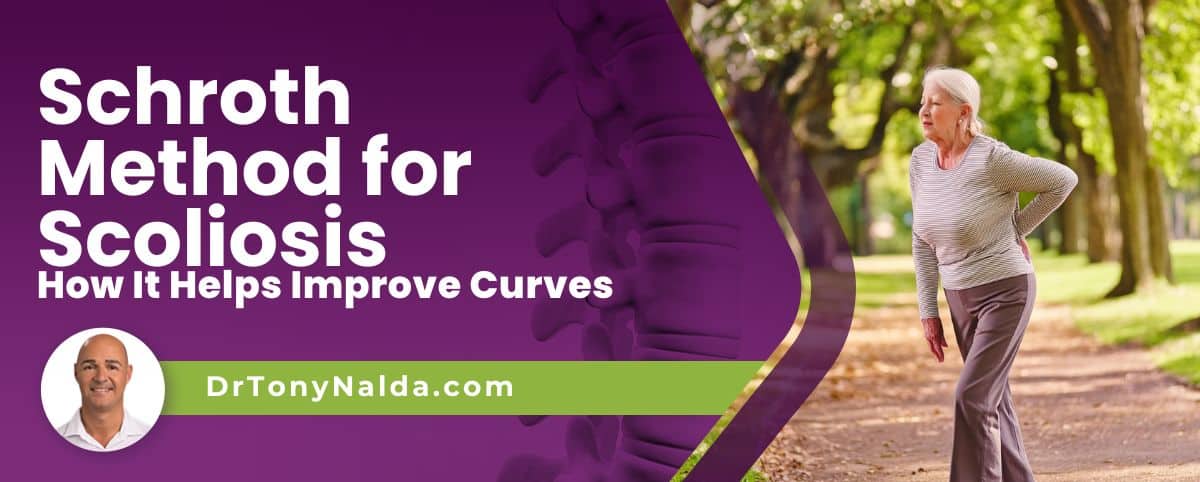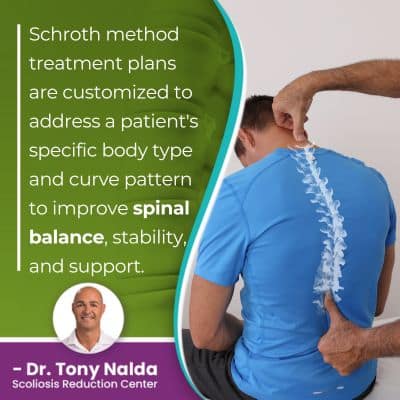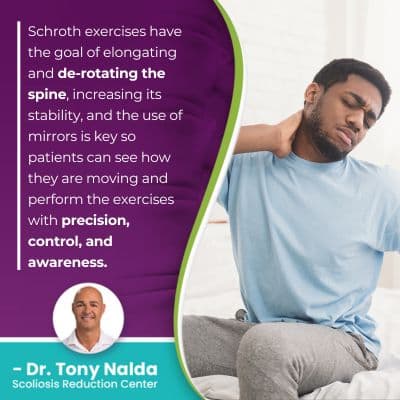Schroth Method for Scoliosis: How It Helps Improve Curves

There are different ways to treat scoliosis, and it's important to understand how they shape long-term spinal health and function: something that can impact overall quality of life. The Schroth method was developed by Katharina Schroth, who had scoliosis herself, and has the goal of repositioning the spine.
Scoliosis curves are progressive, and the Schroth method for scoliosis is a physical therapy-based approach to treatment; it focuses on improving muscle strength, symmetry, breathing patterns, and postural awareness.
In order to better understand how scoliosis responds to treatment, let's start with how the condition is diagnosed and classified.
Table of Contents
Diagnosing and Classifying Scoliosis
With close to seven million people living with scoliosis in the United States alone, the condition is highly prevalent, and as the main spinal condition to affect school-aged children, awareness is important.
When scoliosis is diagnosed, part of the process involves further classifying conditions based on key patient/condition variables.
Further classifying conditions doesn't just streamline the treatment process; it informs the crafting of effective treatment plans.
Scoliosis is diagnosed when an unnatural sideways bending and twisting spinal curve has developed, and it's the rotational component that makes scoliosis a complex 3-dimensional spinal condition.
And the size of the unnatural spinal curve has to be of a minimum size to be diagnosed as scoliosis: minimum Cobb angle measurement of at least 10 degrees.
Cobb Angle and Condition Severity
A patient's Cobb angle is determined during a scoliosis X-ray which is needed to see what's really happening in and around the spine and to confirm a rotational component.
Condition severity is based on Cobb angle; the higher the Cobb angle, the more severe the condition and the more noticeable its effects are likely to be.
In children, postural changes are the most common symptoms of scoliosis, and for adults, it's pain as scoliosis doesn't become a compressive condition until skeletal maturity has been reached, and it's compression (uneven pressure) of the spine and its surrounding muscles and nerves that causes the majority of condition-related pain.
Scoliosis pain can include muscle pain, rib cage pain, back pain, and pain that radiates into the extremities due to nerve compression.
Cobb angles measure how unnaturally tilted the vertebrae (bones of the spine) are at the apex of the curve; lines are drawn from the tops and bottoms of the vertebrae, and the resulting angle is expressed in degrees.
- Mild scoliosis is diagnosed with a Cobb angle measurement of between 10 and 25 degrees.
- Moderate scoliosis is diagnosed with Cobb angle measurements of between 25 and 40 degrees.
- Severe scoliosis is diagnosed with Cobb angle measurements of 40+ degrees.
- Very-severe scoliosis involves Cobb angle measurements of 80+ degrees.
Once scoliosis is diagnosed and fully classified, the most important decision to be made is how to respond with treatment.
Scoliosis Treatment Options
Scoliosis can be treated surgically or nonsurgically, and the choice to commit to one approach over another will permanently impact the spine.
Surgical treatment for scoliosis involves spinal fusion, and this procedure carries some serious risks, side effects, and potential complications.
Surgical intervention involves fusing the curve's most-tilted vertebrae into one solid bone and attaching metal rods to the spine to hold it in place, and while this can hold the spine in a straight alignment, it can cost the spine in terms of its flexibility and range of motion.
And the reality is that many cases of scoliosis don't require surgery.
Conservative nonsurgical treatment results speak for themselves, and here at the Scoliosis Reduction Center, patients benefit from accessing multiple scoliosis-specific treatment disciplines under one roof.
Conservative treatment is integrative and values the power of exercise and physical therapy to impact scoliosis curves and progression.
When it comes to physical therapy, there are different approaches to how it's applied in scoliosis treatment, and the Schroth method is a treatment approach that focuses on the power of physical therapy to restore muscle symmetry/strength and reduce the curve through improvements to posture and breathing.
The Schroth Method
 Physical therapy is a key facet of a conservative treatment approach; it's not just the spine that's in charge of maintaining its natural curves and alignment; it's also the spine's surrounding muscles.
Physical therapy is a key facet of a conservative treatment approach; it's not just the spine that's in charge of maintaining its natural curves and alignment; it's also the spine's surrounding muscles.
The muscles that run alongside the spine and the muscles of the lower back support the spine and trunk and facilitate a wide range of movement: bending, lifting, and twisting.
The Schroth method believes that through the power of scoliosis exercises and physical therapy, curves can be gradually reduced as patients learn breathing techniques and posture awareness that can help restore spinal balance.
Schroth method treatment plans are customized to address a patient's specific body type and curve pattern to improve spinal balance, stability, and support.
Schroth principles involve postural correction and work towards putting the spine in a more natural position, and this increases core stability, as does increasing core muscle strength and balance.
Muscle Strength and Balance
Scoliosis introduces a lot of uneven forces to the spine, its surrounding muscles and nerves, and the entire body.
As scoliosis is associated with a muscular imbalance, restoring muscle symmetry is a focus of Schroth method exercises.
As an unnatural spinal curve pulls its surrounding muscles in different directions, an imbalance can occur as the muscles on one side of the curve work extra hard to support it, and the muscles on the other side become weak from underuse.
Restoring muscle symmetry through physical therapy and Schroth exercises means a spine that's being optimally supported and stabilized.
Breathing Exercises
Body awareness is particularly important for people with scoliosis; it can mean knowing how to avoid introducing more tension and compression to the spine and how to align the spine as much as possible.
Breathing techniques and exercises are part of the Schroth method and involve teaching patients to breathe into the concave side of their body, known as rotational angular breathing, and this helps with postural awareness.
Postural Awareness
Having patient's observe their movement pattern and position with the use of mirrors can help with postural awareness.
Chronic poor posture can exacerbate the effects of scoliosis, and postural awareness can help slow further curve progression and over time can help correct the curve.
A spine curvature can be counteracted when it's placed in a different position, and Schroth exercises that re-train how the body moves and positions itself can help scoliosis patients hold their spines in a counteractive position.
Awareness of body mechanics and spinal mechanics can help patients understand their condition, spine, and how treatment for scoliosis can help.
The Schroth method can impact scoliosis in all 3 anatomical planes for better spinal support, balance, and stability.
Schroth Exercises
 Schroth exercises have the goal of elongating and de-rotating the spine, increasing its stability, and the use of mirrors is key so patients can see how they are moving and perform the exercises with precision, control, and awareness.
Schroth exercises have the goal of elongating and de-rotating the spine, increasing its stability, and the use of mirrors is key so patients can see how they are moving and perform the exercises with precision, control, and awareness.
By elongating the spine and extending it, its position is being pulled out of the sideways bend, and de-rotating it is addressing the condition's rotational component and encouraging the spine's return to a straight and neutral alignment.
Schroth exercises is a long-term treatment plan that requires full commitment as these exercises have to be performed daily and precisely as prescribed to be effective.
Treatment plan length and intensity will vary from patient to patient, but most exercise sessions last between 45 minutes and an hour, are to be performed daily for up to at least five months, but again, recommendations are case-specific.
Conclusion
The Schroth method for scoliosis treatment was designed by Katharina Schroth and focuses on postural awareness, breathing patterns, muscle strength and symmetry; it can improve scoliosis curves by making the spine stronger, more flexible, its surrounding muscles stronger, more balanced, and supportive, improving posture, breathing, and elongating the spine.
The approach is a long-term physical therapy-based treatment using mirrors and exercises to de-rotate and elongate the spine, improving its position and alignment, and pulling it out of the unnatural sideways bend and twist.
The exercises also help strengthen and balance the spine's surrounding muscles so it's optimally supported and stabilized; as scoliosis progresses, the spine becomes increasingly unbalanced and unstable, and anything that counteracts that tendency can improve the spine's function, self elongation, and give the spine better and body better balance.
There are many important components of nonsurgical scoliosis treatment, and here at the Center, an integrative approach combines physical therapy with a number of other types of scoliosis treatment for faster corrective results.
Combining condition-specific chiropractic care, scoliosis-specific exercises, physical therapy, corrective bracing, and rehabilitation can help improve patients' quality of daily life by impacting conditions on every level and helping them avoid the need for invasive surgical treatment in the future.
Dr. Tony Nalda
DOCTOR OF CHIROPRACTIC
After receiving an undergraduate degree in psychology and his Doctorate of Chiropractic from Life University, Dr. Nalda settled in Celebration, Florida and proceeded to build one of Central Florida’s most successful chiropractic clinics.
His experience with patients suffering from scoliosis, and the confusion and frustration they faced, led him to seek a specialty in scoliosis care. In 2006 he completed his Intensive Care Certification from CLEAR Institute, a leading scoliosis educational and certification center.
About Dr. Tony Nalda
 Ready to explore scoliosis treatment? Contact Us Now
Ready to explore scoliosis treatment? Contact Us Now





